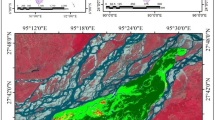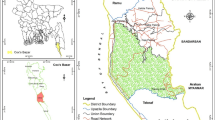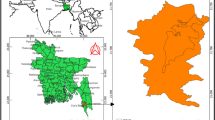Abstract
In the present study, change detection of Sundarban forest has been analyzed over the last 43 years (1975–2018) using Normalized Difference Vegetation Index (NDVI). Spectral indices like NDVI method are more superior as compared with the other technique because NDVI directly derived from the satellite image. The present study deals with five Landsat multispectral satellite data (1975, 1990, 2000, 2010, and 2018) and the prime objective is to extract the meaningful information from the satellite images. The images are classified into four classes on the basis of the NDVI values and that are dense forest, sparse forest, water bodies, and wet land. The classification results revealed that net forest areas were gradually declined by 2.1% (47.48 km2), although it was not homogeneous over the total period and likewise other features also change. The study examined that 94–99%, 39–82%, 59–73%, and 62–91% areas were unchanged for the dense forest, sparse forest, water bodies, and wet land, respectively. The most significant change was that sparse forest areas were translated into wet land and water bodies, and water bodies to wet land. Fragmentation of forest was detected using the estimation of number of patches which shows that numbers of patches were increased over the time, whereas sizes of each patches were gradually decreased. The classification accuracy was quantified through the overall accuracy and Kappa statistic. The present study highlights the changes of different features may be useful for the policy- or decision-makers to take appropriate measures for protection of Sundarban forest.










Similar content being viewed by others
References
Bishop R. Economic efficiency, sustainability and biodiversity. Ambio. 1993;22:69–73.
Sudhakar Reddy C, Jha CS, Dadhwal VK (2013) Assessment and monitoring of long-term forest cover changes in Odisha, India using remote sensing and GIS. Environ Monit Assess. 185: 4399–4415
Geist HJ, Lambin EF. Proximate causes and underlying driving forces of tropical deforestation. Bioscience. 2002;52:143–50.
Ghosh A, Schmidt S, Fickert T, Nüsser M. The Indian Sundarban mangrove forests: history, utilization, conservation strategies and local perception. Diversity. 2015;7(2):149–69.
Gopal B, Chauhan M. Biodiversity and its conservation in the Sundarban Mangrove Ecosystem. Aquat Sci. 2006;68(3):338–54.
Houghton RA. The annual net flux of carbon to the atmosphere from changes in land use 1850–1990. Tellus. 1999;51:298–313.
Rawat JS, Kumar M. Monitoring land use/cover change using remote sensing and GIS techniques: a case study of Hawalbagh block, district Almora, Uttarakhand, India. The Egypt J Remote Sens Space Sci. 2015;18:77–84.
Schulz JJ, Cayuela L, Echeverria C, Salas J, Jose, Marı´a Rey Benayas. . Monitoring land cover change of the dryland forest landscape of Central Chile (1975–2008). Appl Geogr. 2010;30:436–47.
Jonsson P, Eklundh L. Seasonality extraction by function fitting to time series of satellite sensor data. IEEE Trans Geosci Remote Sens. 2002;40(8):1824–32.
Lunetta R, Knight J, Ediriwickrema J, Lyon J, Worthy L. Land-cover change detection using multi-temporal MODIS NDVI data. Remote Sens Environ. 2006;105:142–54.
Ghebrezgabher MG, Yang T, Yang X, Wang X, Khan M. Extracting and analyzing forest and woodland cover change in Eritrea based on landsat data using supervised classification. Egypt J Remote Sens Space Sci. 2016;19:37–47.
Redowan M, Akter S, Islam N. Analysis of forest cover change at Khadimnagar National Park, Sylhet, Bangladesh, using Landsat TM and GIS data. J For Res. 2014;25(2):393–400.
Myers N, Mittermeier RA, Mittermeier CG, et al. Biodiversity hotspots for conservation priorities. Nature. 2000;403:853–8.
Pettorellia N, Vika JO, Mysteruda A, Gaillardb J, Tuckerc CJ, Stensetha NC. Using the satellite-derived NDVI to assess ecological responses to environmental change. Trends Ecol Evol. 2005;20(9):503–10.
Raha A, Das S, Banerjee K, Mitra A. Climate change impacts on Indian Sunderbans: a time series analysis (1924–2008). Biodivers Conserv. 2012;21(5):1289–307.
Rakesh Kumar S, Nandy RA, Kushwah SPS. Forest covers dynamics analysis and prediction modeling using logistic regression model. Ecol Ind. October 2014;45:444–55.
Ray R, Jana TK. Carbon sequestration by mangrove forest: One approach for managing carbon dioxide emission from coal-based power plant. Atmos Environ. 2017;171:149–54.
Roerink G, Menenti M, Verhoef W. Reconstructing cloud free NDVI composites using fourier analysis of time series. Int J Remote Sens. 2000;21(9):1911–7.
Giri S, Mukhopadhyay A, Hazra S, Mukherjee S, Roy D, Ghosh S, Ghosh T, Mitra D. A study on abundance and distribution of mangrove species in Indian Sundarban using remote sensing technique. J Coast Conserv. 2014;18:359–67.
Shukla J, Nobre C, Sellers P. Amazon deforestation and climate change. Science. 1990;247:1322–5.
Meera Gandhi G, Parthiban S, Thummalu N, Christy A (2015) Ndvi: vegetation change detection using remote sensing and Gis—A case study of vellore district. Proc Comput Sci 57:1199-1210
Alphan H, Ali Derse M. Change detection in Southern Turkey using normalized difference vegetation index (NDVI). J Environ Eng Landsc Manag. 2013;21:12–8.
Myeong S, Nowak DJ, Duggin MJA. “Temporal analysis of urban forest carbon storage using remote sensing”, Remote Sens. Environ. 2006;101:277–82.
Puyravaud JP. Standardizing the calculation of the annual rate of deforestation. For Ecol Manage. 2003;177:593–6.
Funding
The authors declare that they have no funding.
Author information
Authors and Affiliations
Corresponding author
Ethics declarations
Conflict of Interest
The authors declare that they have no conflict of interest.
Additional information
Publisher's Note
Springer Nature remains neutral with regard to jurisdictional claims in published maps and institutional affiliations.
This article is part of the topical collection “Next-Generation Digital Transformation through Intelligent Computing” guest edited by PN Suganthan, Paramartha Dutta, Jyotsna Kumar Mandal and Somnath Mukhopadhyay.
Rights and permissions
About this article
Cite this article
Kundu, K., Halder, P. & Mandal, J.K. Change Detection and Patch Analysis of Sundarban Forest During 1975–2018 Using Remote Sensing and GIS Data. SN COMPUT. SCI. 2, 364 (2021). https://doi.org/10.1007/s42979-021-00749-8
Received:
Accepted:
Published:
DOI: https://doi.org/10.1007/s42979-021-00749-8




